Stop Wasting Money – Choose the Perfect Wheel Loader for Your Project
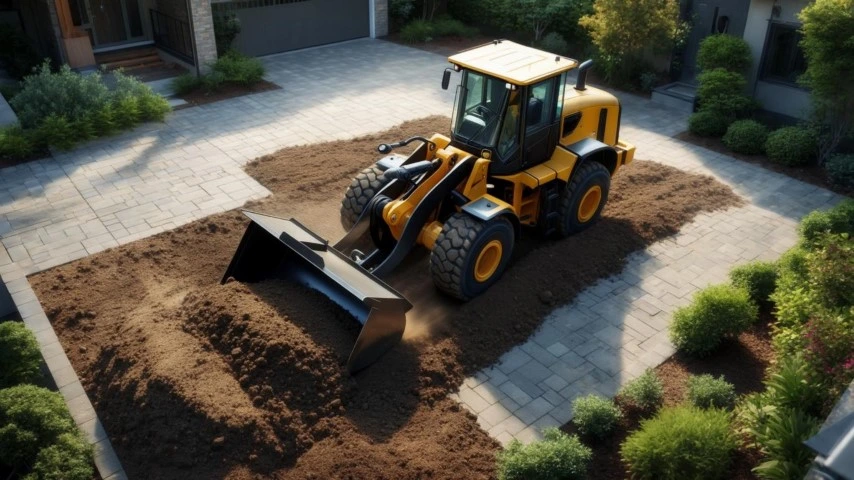
I still remember my first big landscaping job—preparing uneven terrain for a new garden courtyard. I hesitated between a compact skid steer and a mid‑size wheel loader; in the end, choosing the right machine saved me days of labor and thousands in costs. That experience taught me that selecting the right wheel loader is about matching machine capabilities to project demands—and that knowledge has powered countless successful projects of mine.
A thoughtfully chosen wheel loader drives project efficiency by reducing cycle times, minimizing operator fatigue, and cutting fuel consumption. When specs, attachments, and terrain compatibility align perfectly, you unlock safer job sites and lower total cost of ownership—whether you own the machine or rent it. Industry leaders like Caterpillar highlight how the right loader “sets the standard for reliability, productivity, fuel efficiency, versatility and operator comfort” Cat.com, while rental experts note that having the tailored equipment on-site can shave up to 30% off operating costs by avoiding delays and downtime FleetNow.
For renters especially, the process can feel overwhelming: dozens of bucket sizes, horsepower ratings, and tire options. But it doesn’t have to be. By breaking your decision down into five clear steps—from assessing project requirements to vetting your rental provider—you can navigate spec sheets and rental contracts with confidence. In this guide, we’ll demystify technical jargon, share lessons drawn from real jobs, and embed expert tips to help you pick a loader that’s right for your timeline, budget, and site conditions Herc Rentals.
Whether you’re tackling a small residential garden or a large‑scale earthmoving project, this post will walk you through:
- Assessing Your Project Requirements—define exactly what you need the machine to do.
- Understanding Wheel Loader Specifications—translate spec sheets into real‑world performance.
- Evaluating Budget & Rental Terms—compare daily, weekly, and monthly rates, and avoid hidden fees.
- Prioritizing Safety & Operator Requirements—ensure your crew is trained and protected.
- Choosing a Reliable Rental Provider—inspect machines and vet contracts for peace of mind.
By the end, you’ll have a step‑by‑step blueprint to select the ideal wheel loader—no more guesswork, just the right tool for the job.
Assess Your Project Requirements
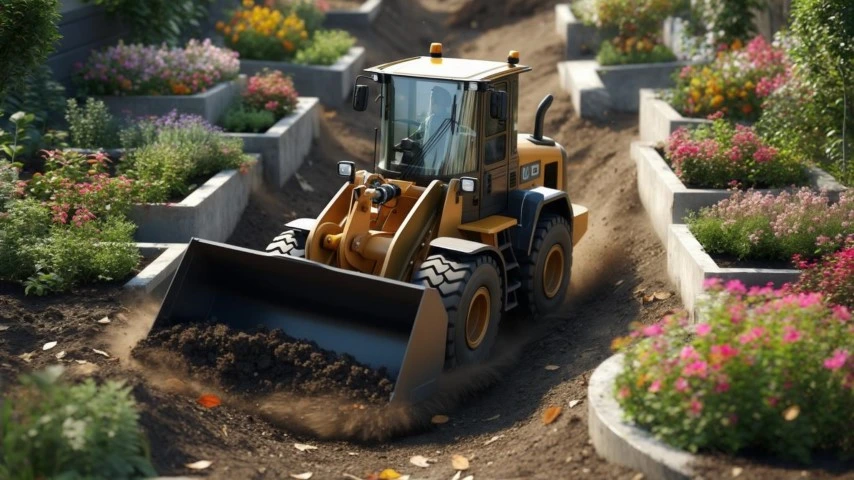
Every successful equipment rental starts with a clear understanding of the project’s demands. Nail your requirements in this phase, and the rest of the process becomes straightforward:
Type of Project
- Construction: Loading and hauling earth, aggregate, or demolition debris demands a loader with high breakout force and sturdy Z‑bar linkage. Models like the John Deere 304K (48 kW/64 hp) excel in residential build‑outs doggett.com.
- Agriculture: Handling silage, feed, or bales often calls for general‑purpose or grapple buckets; consider loaders with bale grapple attachments for efficient crop handling. Many agricultural sites also benefit from compact units for barn work.
- Landscaping: If you’re grading soil and moving mulch, a smaller loader (1–2 yd³ bucket) with foam‑filled tires can minimize turf damage. For example, a Cat 910 compact wheel loader provides nimble performance in tight spaces Compact Equipment Magazine.
- Snow Removal: Snow wings and high‑dump buckets are essential attachments. Electric or Tier 4 Final diesel models offer improved cold‑start reliability and reduced emissions in urban areas.
Project Size
- Small Sites (Residential/Commercial Landscaping): Narrow sites with limited access require compact wheel loaders with buckets under 2 yd³. Compact models (e.g., Cat 906M) balance power and maneuverability.
- Medium Projects (Parking Lots, Road Maintenance): Mid‑size loaders (2.5–4 yd³ buckets) with 80–150 hp engines can handle asphalt and aggregate efficiently.
- Large‑Scale Operations (Mining, Quarrying): For high‑volume material movement, large loaders (5+ yd³ buckets, 200+ hp engines) like the Cat 995 are engineered for continuous heavy‑duty cycles Scene7.
Terrain Conditions
- Rocky or Uneven Ground: Seek machines with pneumatic or foam‑filled tires for traction and puncture resistance. Solid press‑on tires offer flat‑proof durability but can compromise ride quality—solid tires last 3–4× longer than pneumatics but ride rougher Sentry Tiregalileowheel.com.
- Muddy/Soft Soils: Wider tires or tracks (on track‑loader variants) improve floatation. Consider poly‑filled pneumatic tires for balance of comfort and puncture resistance.
- Paved Urban Sites: Standard pneumatic tires minimize surface damage and provide smoother operation on concrete.
Material Handling
- Loose Aggregates (Gravel, Sand): General‑purpose buckets (flat‑floor design) optimize cycle times. High‑dump buckets reduce spillage.
- Heavy Rocks or Demolition Debris: Rock buckets with reinforced cutting edges and higher breakout forces prevent damage and boost loading efficiency.
- Snow and Light Debris: Multipurpose or snow‑specific buckets—often reversible—let you switch between plowing and loading without changing attachments.
By mapping these criteria to your site, you can eliminate models that don’t fit and focus on a shortlist of loaders that align with your exact needs.
Understand Wheel Loader Specifications
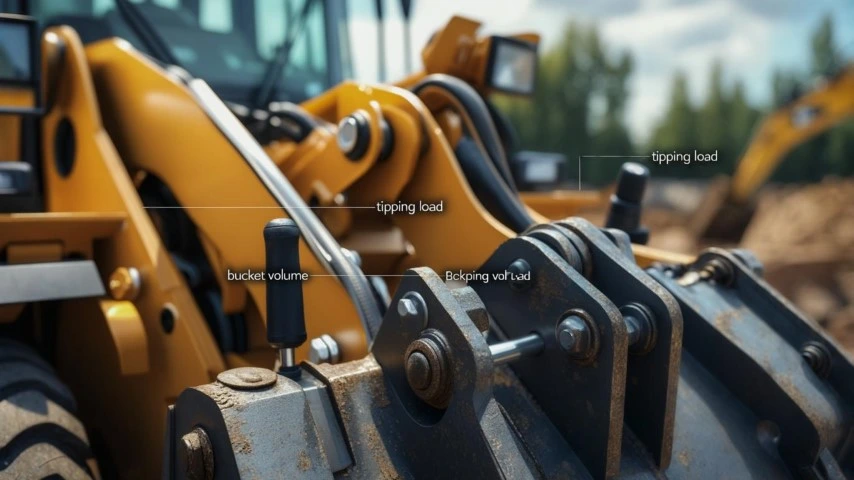
Spec sheets can be intimidating, but key metrics tell the story of on‑site performance. Let’s decode the jargon:
Size & Capacity
- Bucket Volume: Measured in cubic yards (yd³) or cubic meters (m³), bucket size dictates how much material you move per cycle. Compact loaders range 1–3 yd³; large loaders exceed 4 yd³ Cat.com.
- Operating Weight: Heavier machines deliver more stability under load but can be harder to transport. Match the loader’s weight to site access limits (e.g., trailer capacity).
- Tipping Load (Full‑Turn Static Tipping Load): The maximum weight a loader can carry with the bucket at full turn before tipping. Higher tipping loads correlate with safer operation on steep grades Scene7.
Horsepower & Engine Type
- Diesel Engines: The industry standard for heavy‑duty tasks, offering robust torque and long run times. Tier 4 Final diesel engines meet strict emissions while maintaining power. The Cat C32B engine on the 993 provides 1,039 hp (gross) under Tier 4 Final guidelines Scene7.
- Electric & Hybrid Models: Zero emissions and reduced noise make electric loaders ideal for indoor or noise‑sensitive sites. Electric wheel loaders feature regenerative braking and 6–8 hours of runtime per charge know-howequipment.com.
Attachments & Versatility
- Bucket Types: General‑purpose, rock, snow, multi‑purpose, and high‑dump buckets each serve specific tasks.
- Work Tools: Beyond buckets, loaders can be fitted with forks, grapples, augers, brooms, and snow wings. Caterpillar’s attachment catalog offers over 50 specialized tools for wheel loaders Cat.com.
- Quick Couplers: Vertical and horizontal couplers enable tool changes in under a minute, maximizing uptime.
When comparing models, build a spec matrix that aligns bucket size, tipping load, horsepower, and available attachments to your project checklist. That clarity will guide you to the exact make and model you need.
Evaluate Budget & Rental Terms
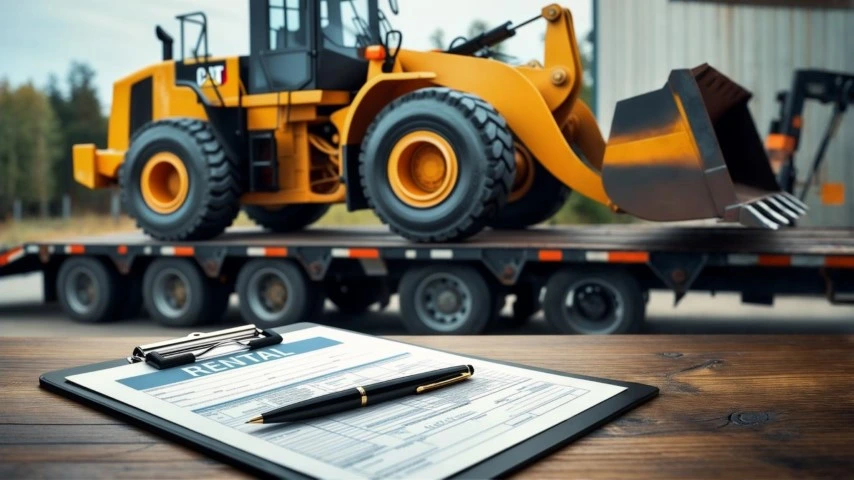
Once you’ve narrowed down specs, the next pivotal step is comparing rental costs and contract terms:
Short‑Term vs. Long‑Term Rentals
- Daily Rates: Ideal for projects under a week or emergency tasks. Expect to pay a premium—around $785–$926/day for 2.5–4.5 yd³ mid‑size loaders New York State Online Services.
- Weekly Rates: Typically 2.5–3× the daily rate; weekly rentals can yield 20–30% savings over daily tariffs.
- Monthly Rates: Best for extended jobs—monthly rates often cap at 6–7× the weekly rate, unlocking up to 50% off daily pricing New York State Online Services.
Typical Rental Rates (New York State Contract)
| Bucket Size (yd³) | Daily Rate | Weekly Rate | Monthly Rate | Delivery Fee (≤30 mi) |
|---|---|---|---|---|
| 2.5–3.4 (MP bucket) | $785 | $2,208 | $5,792 | $250 |
| 3.5–3.9 (STD bucket) | $796 | $2,208 | $5,792 | $250 |
| 4.0–4.5 (STD bucket) | $926 | $2,343 | $7,107 | $250 |
| 4.0–4.5 (MP bucket) | $991 | $2,706 | $7,345 | $250 |
| Source: New York OGS Pricing Schedule New York State Online Services |
Hidden Costs to Avoid
- Delivery & Pickup Fees: Often $200–$300 per round trip.
- Fuel Charges: Some contracts bill by fuel usage or require return with “full tank” provisions.
- Insurance & Damage Waivers: Carefully review liability coverage—waivers typically add 10–15% to your base rate.
- Attachment Rental: Specialty buckets or forks may be extra; confirm if attachments are included in the base price Herc Rentals.
Rent‑to‑Own Options
If your timeline is uncertain, flexible rent‑to‑own plans can apply rental payments toward purchase. Check out our Rent‑to‑Own Plans for details on how to lock in equipment you know you’ll need long term.
By laying out true all‑in costs and comparing short vs. long-duration scenarios, you’ll steer clear of surprise fees and maximize your budget.
Prioritize Safety & Operator Requirements
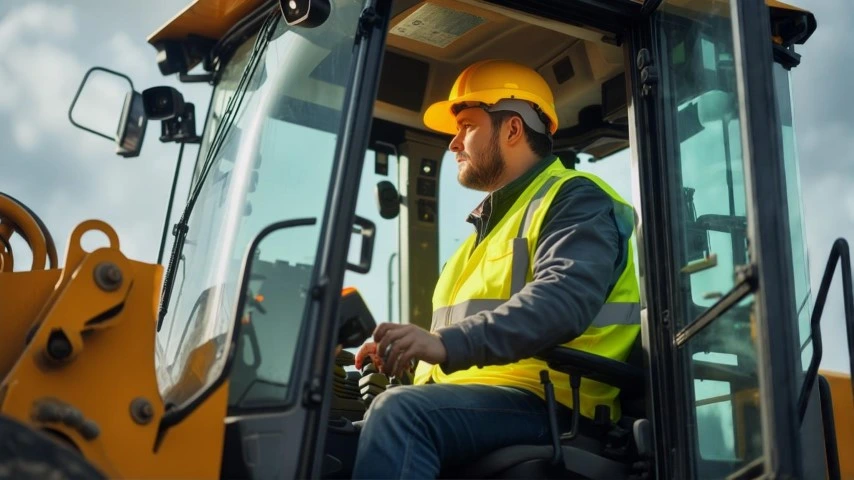
A safe operation hinges on both machine features and qualified operators:
Operator Skill Level
- Certification: OSHA requires operators of earthmoving equipment to be trained, tested, and certified by an accredited agency—covering machine‑specific written and practical exams (29 CFR 1926.1427) OSHA.
- Experience: Match machine complexity to operator experience—compact loaders vs. large‑class loaders demand different skill sets.
Safety Features
- ROPS/FOPS Cabins: Roll‑Over Protective Structure and Falling Object Protective Structure are non‑negotiable for elevated work Teknoxgroup.
- Backup Cameras & Object Detection: Rearview cameras and radar systems improve visibility around the machine—even a standard Cat 986K comes with Cat Detect and rear‑vision cameras Teknoxgroup.
- LED Work Lights: Provides crisp illumination for dawn, dusk, or indoor work.
- Seat Belts & Alarms: Ensure 3‑point retractable belts and audible backup alarms are present and functional (OSHA 1910.178(l)) OSHA.
Site‑Specific Requirements
- Noise Restrictions: Electric models run <70 dB—ideal for urban or residential areas at night know-howequipment.com.
- Emission Zones: Tier 4 Final engines meet stringent local and federal regulations—crucial for inner-city projects or LEED‑certified builds.
- Training & Safety Meetings: Regular toolbox talks reinforce safe practices and emergency protocols; documented training can help mitigate liability.
Prioritize machines with built‑in safety tech and verify each operator’s credentials before start‑up. A compliant, well‑trained crew is your first line of defense against accidents and costly downtime.
Choose a Reliable Rental Provider
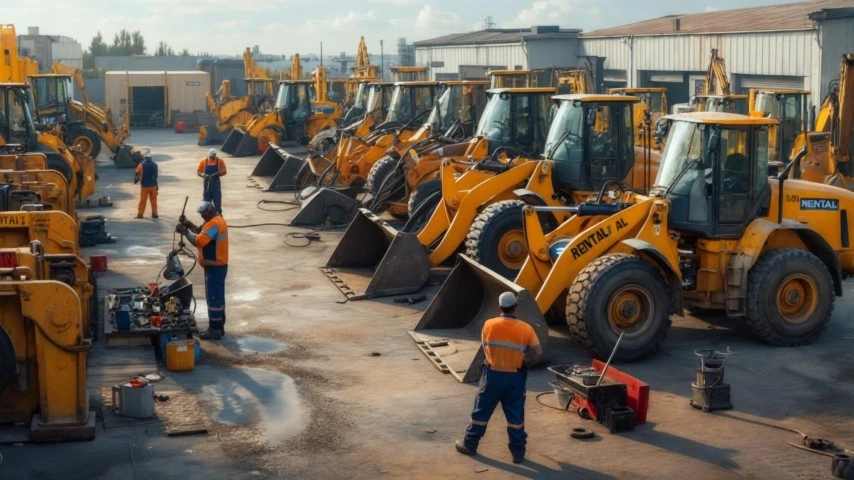
An honest, responsive rental partner ensures your operation stays on track:
Checklist for Rental Companies
- Fleet Maintenance: Look for providers that perform daily equipment checks—ideally documented in a digital system.
- Transparent Contracts: Rates, fees, insurance, and service policies clearly spelled out—no hidden clauses.
- 24/7 Support & Emergency Service: Providers like Herc Rentals guarantee round‑the‑clock service calls and safety training Herc Rentals.
- Telematics & Tracking: Real‑time data on machine hours, location, and performance minimizes overages.
Inspect Before Renting
Perform a thorough walk‑around using a preventive maintenance checklist:
- Fluid Levels: Fuel, engine oil, hydraulic, coolant, and DEF—verify all are topped off Compact Equipment Magazine.
- Tire Condition: Check pressures, tread wear, and inspect for cuts or bulges Compact Equipment Magazine.
- Hydraulic Systems: Inspect hoses, cylinders, and test for smooth operation—listen for irregular noises doForms.
- Service History: Ask for maintenance logs to confirm recent filter changes and major inspections Machinery Trader.
Don’t accept the first quote: get at least three bids, compare machine age, service records, and support offerings. The right provider becomes a long‑term partner, not just a vendor.
Conclusion
Choosing the perfect wheel loader comes down to five key pillars:
- Project Fit—match machine size, capacity, and terrain compatibility.
- Specs Mastery—understand bucket volume, tipping load, horsepower, and attachments.
- Cost Clarity—compare daily, weekly, and monthly rates, watching for hidden fees.
- Safety First—verify operator certifications and advanced protective features.
- Trusted Partner—inspect machines and sign transparent contracts with a dependable rental company.
Ready to rent the perfect wheel loader? Contact Us for expert advice, transparent pricing, and competitive rates. Let’s power your next project with the right equipment and support!
